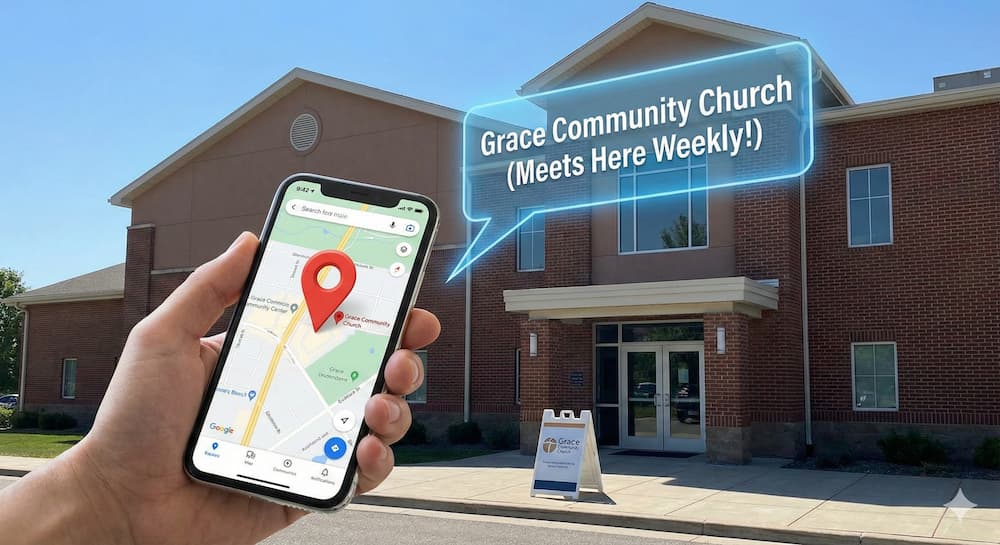How to Create a Content Strategy That Drives People to Your Church
Content possesses a God-like characteristic in its presence.

Whether you’re at home or work, in a car, flying in a plane, riding on a boat or your phone, tablet, or laptop, you live in a sea of information.
You cannot escape the reach of content unless you travel to a remote part of the world without access to the Internet, television, or radio.
That’s not all.
Your church’s digital presence is continuously vying for more content.
From your church’s website, social media accounts, emails, to bulletins, announcements, and sermons, you and your church are pressured to create content.
For your church to consistently create content that reaches your intended audience and leads them to take action, you will need to create a content strategy.
Developing a content strategy sounds challenging and time-consuming on the surface, but it’s an easy concept to grasp and implement.
Here are three steps you need to take to create your church’s content strategy.
#1. Prepare
Before you do anything else, take the time to lay a solid foundation for your content strategy by answering these two questions:
1. What are your top 3–5 goals?
2. Who is the primary audience you are trying to reach?
#2. Plan
You will be tempted to skip directly to starting a new Facebook Page or account on Snapchat, but don’t. Starting directly with the tactics you want to use is like throwing mud on the wall with the hopes that something will stick.
Before lobbing random blogs of mud on the wall, take these two necessary steps before you produce one more shred of content:
1. Determine what channels you need to use to reach your audience — e.g., website, Facebook, Instagram
2. Develop a plan that includes what content you will create for what channel and when you will publish it
By creating a plan, you'll be able to focus on increasing blog traffic and creating awareness of your church in your community.
#3. Produce
Looking at the plan you just created on paper can be overwhelming.
From creating content for your website, social media accounts, and more, you have your work cut out for you. Thankfully, you don’t have to create everything from scratch.
Every week, your pastor’s sermon will produce a tremendous amount of content. Here are seven ways you can repurpose a sermon into different types of content.
Your turn
These three steps are the building blocks to developing an effective content strategy for your church.
After you have these pillars in place, you can build upon this foundation by polishing your content strategy.
In other words, measure how well your activity is doing and adapt your plan as you move forward.
Sign Up for Product Updates
Whether you’re at home or work, in a car, flying in a plane, riding on a boat or your phone, tablet, or laptop, you live in a sea of information.
You cannot escape the reach of content unless you travel to a remote part of the world without access to the Internet, television, or radio.
That’s not all.
Your church’s digital presence is continuously vying for more content.
From your church’s website, social media accounts, emails, to bulletins, announcements, and sermons, you and your church are pressured to create content.
For your church to consistently create content that reaches your intended audience and leads them to take action, you will need to create a content strategy.
Developing a content strategy sounds challenging and time-consuming on the surface, but it’s an easy concept to grasp and implement.
Here are three steps you need to take to create your church’s content strategy.
#1. Prepare
Before you do anything else, take the time to lay a solid foundation for your content strategy by answering these two questions:
1. What are your top 3–5 goals?
2. Who is the primary audience you are trying to reach?
#2. Plan
You will be tempted to skip directly to starting a new Facebook Page or account on Snapchat, but don’t. Starting directly with the tactics you want to use is like throwing mud on the wall with the hopes that something will stick.
Before lobbing random blogs of mud on the wall, take these two necessary steps before you produce one more shred of content:
1. Determine what channels you need to use to reach your audience — e.g., website, Facebook, Instagram
2. Develop a plan that includes what content you will create for what channel and when you will publish it
By creating a plan, you'll be able to focus on increasing blog traffic and creating awareness of your church in your community.
#3. Produce
Looking at the plan you just created on paper can be overwhelming.
From creating content for your website, social media accounts, and more, you have your work cut out for you. Thankfully, you don’t have to create everything from scratch.
Every week, your pastor’s sermon will produce a tremendous amount of content. Here are seven ways you can repurpose a sermon into different types of content.
Your turn
These three steps are the building blocks to developing an effective content strategy for your church.
After you have these pillars in place, you can build upon this foundation by polishing your content strategy.
In other words, measure how well your activity is doing and adapt your plan as you move forward.
podcast transcript
Whether you’re at home or work, in a car, flying in a plane, riding on a boat or your phone, tablet, or laptop, you live in a sea of information.
You cannot escape the reach of content unless you travel to a remote part of the world without access to the Internet, television, or radio.
That’s not all.
Your church’s digital presence is continuously vying for more content.
From your church’s website, social media accounts, emails, to bulletins, announcements, and sermons, you and your church are pressured to create content.
For your church to consistently create content that reaches your intended audience and leads them to take action, you will need to create a content strategy.
Developing a content strategy sounds challenging and time-consuming on the surface, but it’s an easy concept to grasp and implement.
Here are three steps you need to take to create your church’s content strategy.
#1. Prepare
Before you do anything else, take the time to lay a solid foundation for your content strategy by answering these two questions:
1. What are your top 3–5 goals?
2. Who is the primary audience you are trying to reach?
#2. Plan
You will be tempted to skip directly to starting a new Facebook Page or account on Snapchat, but don’t. Starting directly with the tactics you want to use is like throwing mud on the wall with the hopes that something will stick.
Before lobbing random blogs of mud on the wall, take these two necessary steps before you produce one more shred of content:
1. Determine what channels you need to use to reach your audience — e.g., website, Facebook, Instagram
2. Develop a plan that includes what content you will create for what channel and when you will publish it
By creating a plan, you'll be able to focus on increasing blog traffic and creating awareness of your church in your community.
#3. Produce
Looking at the plan you just created on paper can be overwhelming.
From creating content for your website, social media accounts, and more, you have your work cut out for you. Thankfully, you don’t have to create everything from scratch.
Every week, your pastor’s sermon will produce a tremendous amount of content. Here are seven ways you can repurpose a sermon into different types of content.
Your turn
These three steps are the building blocks to developing an effective content strategy for your church.
After you have these pillars in place, you can build upon this foundation by polishing your content strategy.
In other words, measure how well your activity is doing and adapt your plan as you move forward.
VIDEO transcript
Whether you’re at home or work, in a car, flying in a plane, riding on a boat or your phone, tablet, or laptop, you live in a sea of information.
You cannot escape the reach of content unless you travel to a remote part of the world without access to the Internet, television, or radio.
That’s not all.
Your church’s digital presence is continuously vying for more content.
From your church’s website, social media accounts, emails, to bulletins, announcements, and sermons, you and your church are pressured to create content.
For your church to consistently create content that reaches your intended audience and leads them to take action, you will need to create a content strategy.
Developing a content strategy sounds challenging and time-consuming on the surface, but it’s an easy concept to grasp and implement.
Here are three steps you need to take to create your church’s content strategy.
#1. Prepare
Before you do anything else, take the time to lay a solid foundation for your content strategy by answering these two questions:
1. What are your top 3–5 goals?
2. Who is the primary audience you are trying to reach?
#2. Plan
You will be tempted to skip directly to starting a new Facebook Page or account on Snapchat, but don’t. Starting directly with the tactics you want to use is like throwing mud on the wall with the hopes that something will stick.
Before lobbing random blogs of mud on the wall, take these two necessary steps before you produce one more shred of content:
1. Determine what channels you need to use to reach your audience — e.g., website, Facebook, Instagram
2. Develop a plan that includes what content you will create for what channel and when you will publish it
By creating a plan, you'll be able to focus on increasing blog traffic and creating awareness of your church in your community.
#3. Produce
Looking at the plan you just created on paper can be overwhelming.
From creating content for your website, social media accounts, and more, you have your work cut out for you. Thankfully, you don’t have to create everything from scratch.
Every week, your pastor’s sermon will produce a tremendous amount of content. Here are seven ways you can repurpose a sermon into different types of content.
Your turn
These three steps are the building blocks to developing an effective content strategy for your church.
After you have these pillars in place, you can build upon this foundation by polishing your content strategy.
In other words, measure how well your activity is doing and adapt your plan as you move forward.


















.jpg)









